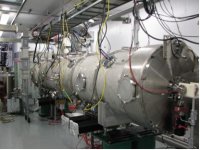 |
 |
|||||||||||||
|
|||||||||||||
|
|||||||||||||
|
At first glance a neutron source used for materials research and a planned particle accelerator to answer questions about matter, forces and the origins of the Universe might not seem to have all that much in common. At least not to the non-accelerator experts among us. At second glance, however, similarities and overlaps appear that turn the Spallation Neutron Source (SNS) at Oak Ridge National Laboratory in the US into a small but powerful parallel experience for the ILC.
The neutron source is driven by a superconducting linear accelerator. Not only that, it is also a routinely operating pulsed superconducting linear accelerator, making it one of the ILC's closest living relative, next to FLASH at DESY. The SNS people have just built a new test facility for the SNS linac cryomodules, and within a few weeks of facility completion, the first cryomodule was fully tested and will be installed in February 2008. The new cryomodules test facility has a five-megawatt and 805-megahertz dedicated radiofrequency (rf) source for full investigation of SNS rf structures. The rf system is set up to power on single or multi-cavity operation, which makes it possible to charaterise all of the cavities' limits, including collective ones. The cryogenics are supplied from a new transfer line off the central helium plant and are operated from the main control room. Just recently, the team removed a cryomodule from the linac and repaired and commissioned it in the new test facility. Once in it, each accelerator cavity of the module was tested for its operational limits while commissioning went on at the same time. “It was amazing - in just a few short days we commissioned the cryomodule facility and also successfully tested the repaired cryomodule,” says John Mammosser, SCRF expert at Oak Ridge. The SNS linac has a couple of more things under construction that could help drive the SCRF expertise: a cleanroom for cavity assembly, a high-pressure rinse for cavity cleaning and a horizontal test cryostat for testing cavities down to 4.2 Kelvin. At SNS the cavities have been operating since 2005. “The need for this facility comes from the power ramp up plan in which the beam power is to increase from currently 200 kilowatts to 1.4 megawatts in the next few years,” explains Mammosser. They see a strong need to build a few spare cryomodules and repair several of the weaker ones. SNS superconducting linac operating experience has identified many cavity-to-cavity interactions such as field emission that can limit their performance, and the SNS linac team is currently developing solutions which could come in handy not just for SNS but other SRF accelerators including ILC and the XFEL as well. The 300-metre superconducting linac contains 23 cryomodules that are cooled to an operating temperature of 2 Kelvin. These superconducting structures are extremely sensitive to contamination, and their performance can easily be damaged to the point where they are not useful. Having the on-site capability to maintain and test these complicated and expensive pieces of equipment saves Oak Ridge time and money. The SNS linac design is based in part on developments in the work from the TESLA Technology Collaboration. The parameters are different, in that it operates between 186 million electron-volts (MeV) to 1 billion electron-volts (GeV) and that the resonant frequency of the SNS linac is 0.805 GHz, as opposed to 1.3 GHz for ILC. However, the technology has many similar features with the 1.3 GHz structures. In addition, the SNS SRF Test Facility is one of only a handful of such facilities on the planet. SNS has two different styles of cryomodules, a medium-beta and a high-beta type. “Additionally, many other SRF structures can be prepared and assembled at our new test facility,” says Mammosser. “For example, we are planning to build several new cryomodules using standard preparation techniques developed from other labs such as DESY and Jefferson Laboratory.” SNS is also planning a programme to develop new assembly and processing techniques. Their colleagues in the TESLA Technology Collaboration are already curious to hear about the experiences with these facilities. -- Barbara Warmbein |
|||||||||||||
| © International Linear Collider |
